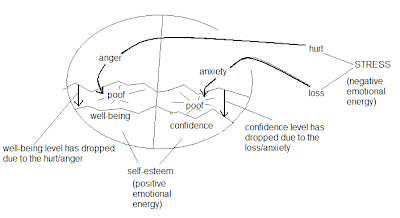Once we start the really hard work of grieving (i.e., after the shock phase has worn off and we really really start feeling terrible), a big challenge is how to view ourselves objectively. All our thoughts seem to be consumed with our lost loved one and how awful the world looks and feels without them. It seems that our only option is to continue to experience the world subjectively, yet this experience brings only pain and suffering. How can we step outside of ourselves? Until we can get a change of perspective, it seems that one miserable week flows seamlessly into another.
I'm reading a fascinating book buy Guy Finley called The Secret of Letting Go. I love reading about mental perspective tools that can dramatically alter the way we see ourselves and the world. The following story does just that [pp 89-92]:
... Twenty minutes later, Timothy found himself on one of the large sound stages where his father was making his newest movie. The next thing he knew, his dad had lifted him onto the high-backed, slick, black chair of one of the cameras. After throwing a few switches and making some adjustments to the lens, he told Tim to look into the camera's eye.
Tim leaned forward and put his eye against the soft rubber cup that covered the eyepiece and, when he did, he let out a high-pitched yelp. All he could see was a monster looking back at him! His father smiled and told him to look again — but this time to keep his eye there, no matter how scary it was.
He was frightened, but he trusted his dad, so he did as he was instructed. The monster was still right there and just as terrifying as before. But this time, as he looked through the camera's eye, he felt his father slowly moving the camera back and away from the monster. As the camera and Timmy pulled back, the scene that Timmy was looking at through the camera began to change. At first there was only the monster, but now Timmy was beginning to see more of the set. Funny old windows and velvet curtains, oak tables and chairs, and lots of other props filled the picture that only a moment before had just been the ugly monster.
To Tim's surprise, his father kept rolling the heavy camera back until now he could see all kinds of lights and microphones suspended over the elaborate set where the monster had been. Back farther still, and now Timmy could see some of the other studio sets and heavily wired ceilings. Way in the distance stood the scary monster.
Timmy knew that his father was teaching him something very important. He already felt a lot better, even though he wasn't sure exactly why. On the way home they stopped for a snack, and his father explained the lesson to him. Let's listen in.
"Sometimes unpleasant or scary things happen to us, like when you looked into the camera and all you could see was the monster. Whenever this happens, all we can do is think about what we saw and how to get away or protect ourselves from the threat. Like what happened with the monster, you didn't want to look again because you didn't want to see it again. The problem with this choice, Timmy, is that even though you don't look at it again, you are still living in and with the original frightening moment, only now this fear has become a fixed point within you as a memory and you take it wherever you go. Even more amazing is that this unpleasant fixed point within you — this scary memory — is more than likely determining where you go and what choices you make, since you are probably, unknowingly, trying to get away from it."
...He gently continued, "You were out on the back porch when I got home. You were feeling worse and worse the more you tried to make the day's events go away. Trying to make any unpleasant thoughts or feelings go away only fixes them in you. Try to understand this. That's why I made you look at the monster again and again while I kept pulling the camera back. The wider the view became in the camera's eye, the less frightening what you were looking at became. Finally, when we pulled all the way back, you could see there was nothing to be frightened about because you could see the whole picture. This is what you must do with every event, every thought and feeling, that crosses your life.
"Whenever you feel scared or anxious, remember this important lesson: mental or emotional suffering takes place only when you have become fixed in the partial. Break your temporary wrong focus and pull back from yourself. The wider you can extend your inner view, the less disturbed you'll be by what you may be seeing."
"...There are great possibilities in this life that are going to take time for you to discover. Life will show itself to you, and as it does you'll know just what to do and who to be. There is never any good reason to worry about anything. Treat those kinds of scary feelings like we did with the monster and just quietly pull back from them; make the scene wider and wider until you see them within the whole picture. Then you will know there was never anything real to be scared about."
I have been experimenting with this technique and have found it to be very helpful. I hope it does the same for you.






